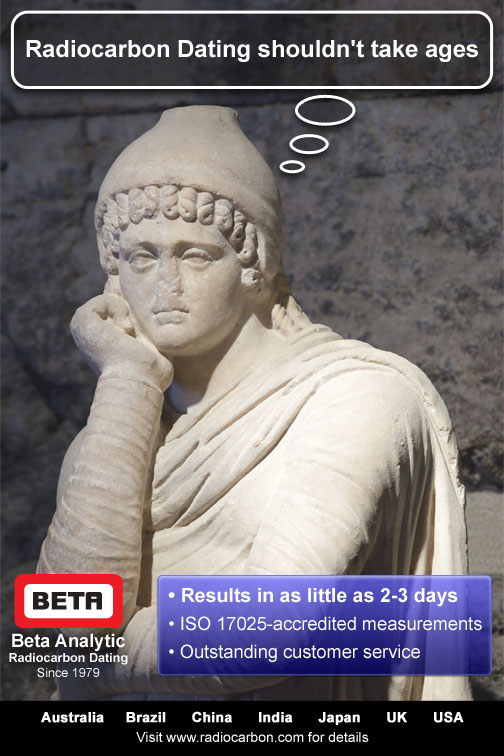Miami Radiocarbon Lab Beta Analytic – Tracer Free and No Subcontractors
Friday, June 27th, 2014
As part of its commitment to provide high-quality results to its clients, ISO/IEC 17025:2005-accredited Beta Analytic does not accept pharmaceutical samples with “tracer Carbon-14” or any other material containing artificial Carbon-14 to eliminate the risk of cross-contamination. Moreover, the Miami radiocarbon dating lab does not engage in “satellite dating” – the practice of preparing individual sample graphite in a remote chemistry lab and then subcontracting an AMS facility for the result.
“Satellite analysis induces indeterminate errors, breaks the chain of custody on quality control, and allows for ambiguity in accountability to the results. All work is done in our laboratory, on our own AMS machines, and our own chemistry lines, ensuring complete chain of custody on quality control and allowing us to be solely accountable to our clients. We can address any questions our clients have using complete and immediately available records. Inquiries are always welcome,” Beta Analytic president Darden Hood says.
High Risk of Cross-Contamination
Pharmaceutical companies evaluate drug metabolism by using a radiolabeled version of the drug under investigation. AMS biomedical laboratories use Carbon-14 as a tracer because it can easily substitute Carbon-12 atoms in the drug molecule and it is relatively safe to handle. Tracer Carbon-14 is a well-known transmittable contaminant to radiocarbon samples, both within the AMS equipment and within the chemistry lab.
“Since the artificial Carbon-14 used in these studies is phenomenally high (enormous) relative to natural levels, once used in an AMS laboratory it becomes ubiquitous. Cross-contamination within the AMS and the chemistry lines cannot be avoided. Although the levels of contamination are acceptable in a biomedical AMS facility, it is not acceptable in a radiocarbon dating facility,” Mr. Hood states.
No Exposure to Artificial Carbon-14
According to ASTM International, the ASTM D6866 standard is applicable to laboratories working without exposure to artificial carbon-14 routinely used in biomedical studies. Artificial carbon-14 can exist within the laboratory at levels 1,000 times or more than 100 % biobased materials and 100,000 times more than 1% biobased materials. Once in the laboratory, artificial 14C can become undetectably ubiquitous on materials and other surfaces but which may randomly contaminate an unknown sample producing inaccurately high biobased results. Despite vigorous attempts to clean up contaminating artificial 14C from a laboratory, isolation has proven to be the only successful method of avoidance. Completely separate chemical laboratories and extreme measures for detection validation are required from laboratories exposed to artificial 14C.
Accepted requirements are:
(1) disclosure to clients that the laboratory working with their products and materials also works with artificial 14C
(2) chemical laboratories in separate buildings for the handling of artificial 14C and biobased samples
(3) separate personnel who do not enter the buildings of the other
(4) no sharing of common areas such as lunch rooms and offices
(5) no sharing of supplies or chemicals between the two
(6) quasi-simultaneous quality assurance measurements within the detector validating the absence of contamination within the detector itself.
Fast Service with No Subcontractors
Beta Analytic does not subcontract work to other labs. Its policy is to have direct contact with clients, maintain complete chain of custody in quality control, use its own AMS machines, and have a complete working knowledge of each analysis to best answer questions once results are available.
The ISO/IEC 17025:2005-accredited radiocarbon Miami-based lab is able to offer such rapid service because all analyses are done in-house. The lab has a dedicated full-time staff of technicians and scientists working overtime, if necessary, to meet its promised delivery times.
For inquiries, please email us at lab@radiocarbon.com or call +(1) 305-662-7760.
References:
Memory effects in an AMS system: Catastrophe and Recovery. J. S. Vogel, J.R. Southon, D.E. Nelson. Radiocarbon, Vol 32, No. 1, 1990, p. 81-83 doi:10.2458/azu_js_rc.32.1252 (Open Access)
Recovery from tracer contamination in AMS sample preparation. A. J. T. Jull, D. J. Donahue, L. J. Toolin. Radiocarbon, Vol. 32, No.1, 1990, p. 84-85 doi:10.2458/azu_js_rc.32.1253 (Open Access)
Prevention and removal of elevated radiocarbon contamination in the LLNL/CAMS natural radiocarbon sample preparation laboratory. Zermeño, et. al. Nuclear Instruments and Methods in Physics Research Section B: Beam Interactions with Materials and Atoms Vol. 223-224, 2004, p. 293-297
doi: 10.1016/j.nimb.2004.04.058
High level 14C contamination and recovery at XI’AN AMS center. Zhou, et. al. Radiocarbon, Vol 54, No. 2, 2012, p. 187-193
doi:10.2458/azu_js_rc.54.16045

SEND SAMPLES |
|---|
| Contact us for prices |
| Prepare Sample |
| Submit Data Sheet Online |
| See Shipment Guidelines |
| Shipping Addresses |
Carbon 14 Dating ServiceWould you like us to track your package? Are you filling out the online form? Read about sample material return Beta Analytic Other Services- d13C and d15N - d18O for carbonates - d2H and d18O for water |
Terms and Conditions



